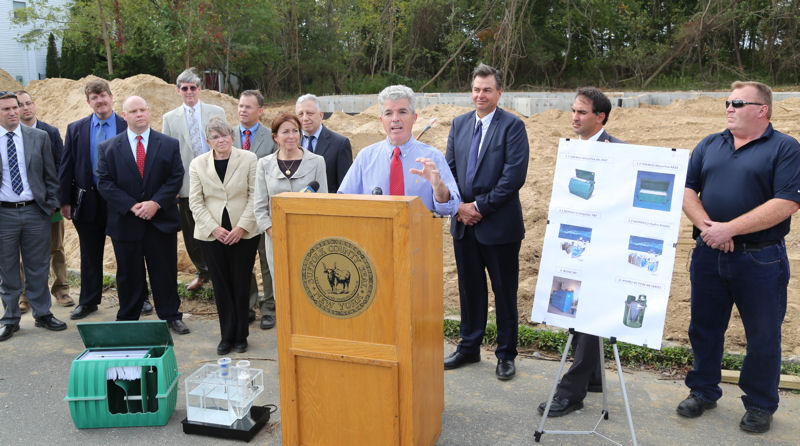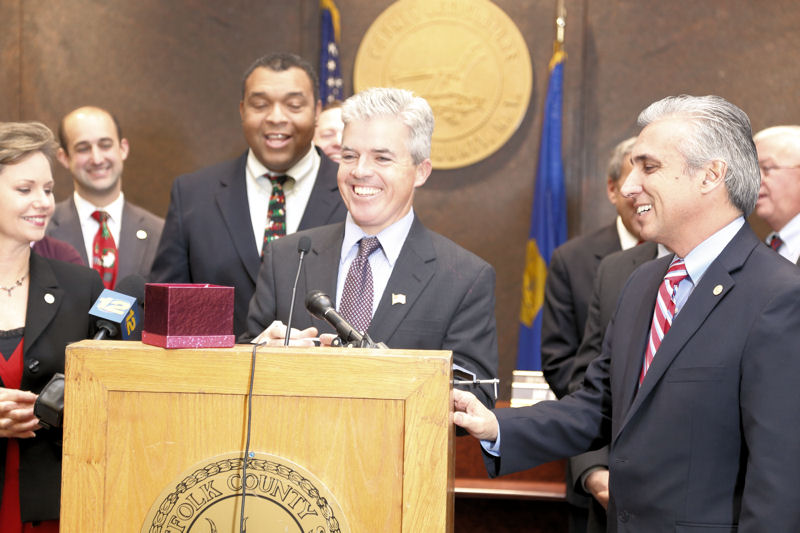
Suffolk County (N.Y.) Executive Steve Bellone announces the county’s free advanced wastewater treatment system lottery that is part of an overall demonstration program that is part of the county’s efforts to help reduce nitrogen loading to surface and groundwater. Photo courtesy of Suffolk County, N.Y.
In areas without collection systems, Suffolk County, N.Y., encourages residents to install more advanced septic systems to reduce nutrient loading to local surface water and groundwater. To promote these installations, the county held a free advanced wastewater treatment system lottery as part of a Septic Demonstration Program.
Residents within the county were allowed to enter for a chance to win one of 19 systems, each worth as much as $15,000. The systems were donated by four manufacturers: BUSSE Green Technologies (Oak Park, Ill.), Norwalk Wastewater Equipment Company Inc. (Norwalk, Ohio), Orenco Systems Inc. (Sutherlin, Ore.), and Hydro-Action Industries (Plymouth, Ind.).
According to a frequently asked questions (FAQ) section of the county’s website, three of the manufacturers’ systems are designed to be installed underground. The remaining system must be installed aboveground in an area such as a basement, garage, or shed, and the system discharges the effluent to an underground leaching system.
The county chose the lottery winners in December.
“We received applications from 15 out of the Suffolk County’s 18 legislative districts,” said Vanessa Baird-Streeter, director of communications for the Office of the Suffolk County Executive. “Two of the three remaining districts are nearly all sewered. Each of the legislators representing these 15 districts drew the name of the winner for his/her respective district.”
Those chosen to participate in the demonstration program now will get system monitoring and maintenance visits from the county, according to the FAQ website. The system also will be shown to small groups for educational purposes.
“It is expected that these educational visits will be about twice a month for the first 6 months and will occur less frequently after that,” the website says. “There may be educational visits for up to 2 years after the systems are installed.”
Collecting Data, Making Strides

Suffolk County (N.Y.) Executive Steve Bellone pulls random names of those who entered the county’s free advanced wastewater treatment system lottery. Winners were chosen from 15 out of the 18 legislative districts in the county. Photo courtesy of Suffolk County, N.Y.
The county held a lottery for these installations rather than installing them at sites chosen by the county. “Our goal was to ensure even and equitable geographic distribution for the 19 advanced onsite septic systems,” Baird-Streeter said. The county believes its strategy worked very well in making sure the systems will be tested on different terrains, she added.
“The systems to be installed must be capable of removing 50% nitrogen as compared to effluent from a standard septic tank,” Baird-Streeter said. “Since the total nitrogen from the septic tank is expected to be 39 mg/L on average, the proposed systems must product a total nitrogen effluent of 19 mg/L or less.”
The demonstration program falls under the county’s Reclaim Our Water Initiative. The county, Long Island’s eastern-most county with a population of 1.5 million, considers all portions of this initiative as integral to the long-term well-being of its waterways, Baird-Streeter said.
“[Suffolk County] has the most number of onsite septic systems in the tri-state area,” Baird-Streeter said. “Our analyses indicated that out of approximately 365,000 individual sanitary systems installed in Suffolk County, there are approximately 209,000 sanitary systems installed in environmentally sensitive areas of concern,” she said.
“Assuming that all of these 209,000 systems are gradually converted to advanced onsite wastewater treatment systems and excluding four county areas that are expected to be sewered within the next 5 years, this would result in an annual reduction of approximately [1.3 million kg] 2.8 million pounds of nitrogen,” Baird-Streeter said.
But while the county encourages residents to shift to these newer treatment systems, it will be collecting data from the current installation sites. Baird-Streeter said the data will be used by the Suffolk County Departments of Health Services and Public Works to evaluate performance of each system.
— LaShell Stratton-Childers, WEF Highlights








January 29, 2015
Featured